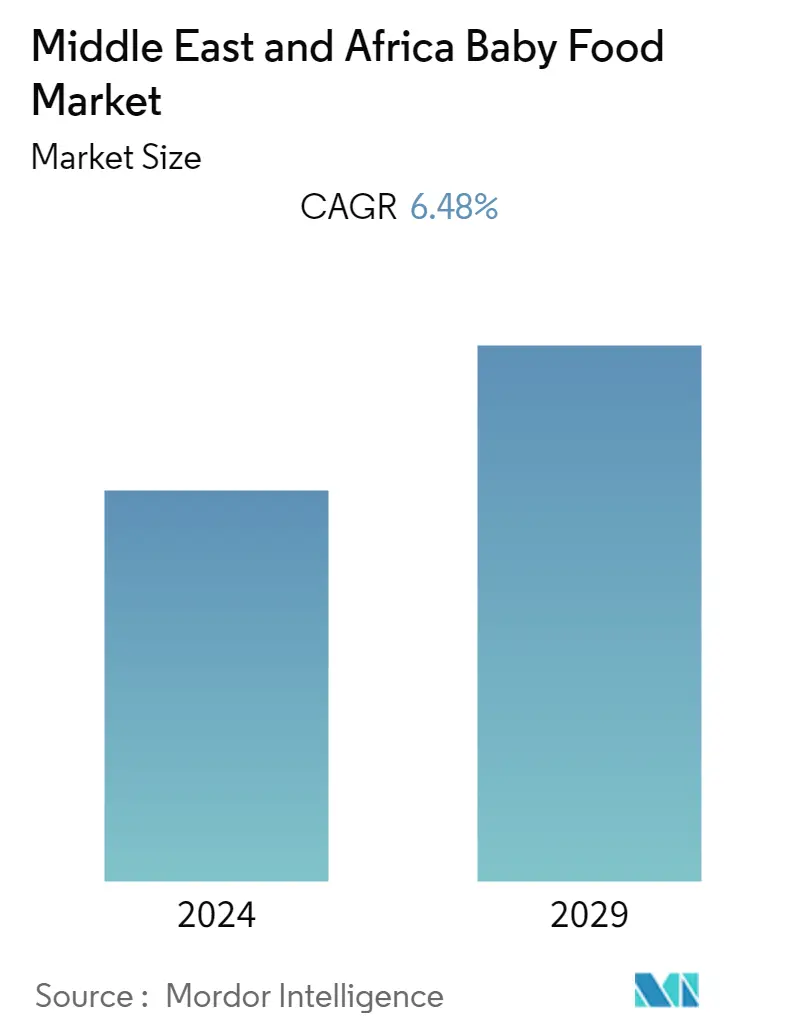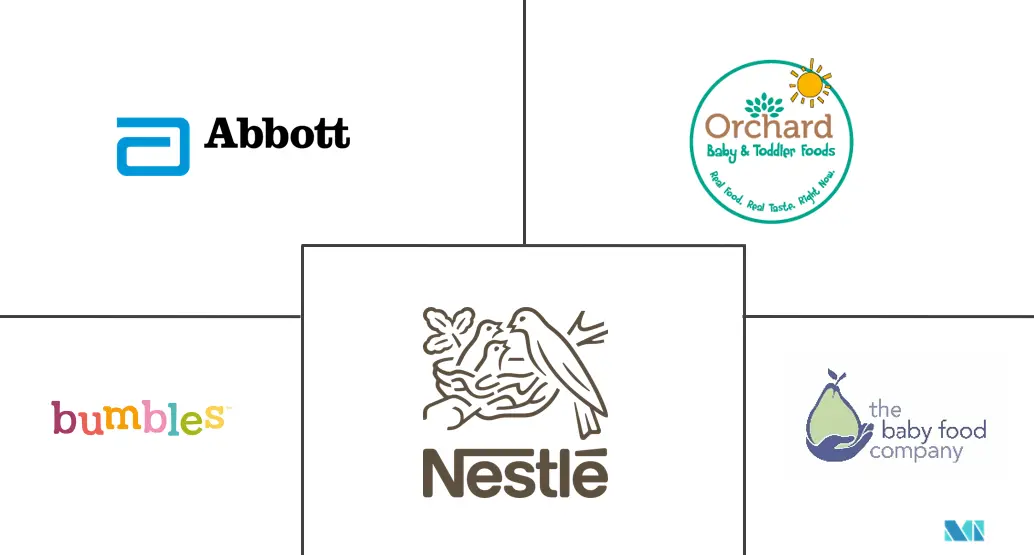Market Size of Middle East and Africa Baby Food Industry

| Study Period | 2019 - 2029 |
| Base Year For Estimation | 2023 |
| Forecast Data Period | 2024 - 2029 |
| Historical Data Period | 2019 - 2022 |
| CAGR | 6.48 % |
| Market Concentration | Low |
Major Players
*Disclaimer: Major Players sorted in no particular order |
MEA Baby Food Market Analysis
The Middle East and Africa baby food market is expected to witness a CAGR of 6.48% during the forecast period.
The demand for baby food in Middle East and Africa has witnessed significant growth over the years as parents have become increasingly aware of the significance of baby food in the nutritional necessity of their child's health. Saudi Arabia has a rapidly developing retail sector, and the market for baby food has grown steadily. The demand for baby food in Saudi Arabia has further potential for growth, given the increased exposure to western lifestyles and the economy's underlying strength.
The market expects growth amid innovations with key ingredients, such as human milk oligosaccharides (HMOs) and probiotics. Over the long term, manufacturers are expected to develop products that support the immune system from infancy. In infant nutrition, parents demand the highest safety and quality standards. Key players in the market constantly reform products to make them more appealing to parents and infants. The rising population of working women and the organized retail market, especially in developing economies, are expected to drive the market's growth over the forecast period.
MEA Baby Food Industry Segmentation
Baby food is any soft, easily digestible meal created particularly for human babies.
The Middle East and African baby food market is segmented by type, distribution channel, and geography. By type, the market has been segmented into milk formula, dried baby food, prepared baby food, and other types. By distribution channel, the market has been segmented into hypermarkets/supermarkets, convenience stores, drug/pharmacies, and other distribution channels. By geography, the market has been segmented into the United Arab Emirates, South Africa, and the Rest of the Middle East and Africa. The report offers market sizes and forecasts in value (USD million) for the abovementioned segments.
| By Type | |
| Milk Formula | |
| Dried Baby Food | |
| Prepared Baby Food | |
| Other Types |
| By Distribution Channel | |
| Hypermarket/Supermarket | |
| Drugstores/Pharmacies | |
| Convenience Stores | |
| Other Distribution Channels |
| By Geography | |
| Saudi Arabia | |
| South Africa | |
| Rest of Middle East and Africa |
Middle East and Africa Baby Food Market Size Summary
The Middle East and Africa baby food market is experiencing robust growth, driven by increasing awareness among parents about the nutritional importance of baby food. This trend is particularly evident in Saudi Arabia, where a burgeoning retail sector and exposure to Western lifestyles are fueling demand. Innovations in baby food, such as the incorporation of human milk oligosaccharides and probiotics, are expected to further propel market expansion. The rise in working women and the growth of organized retail in developing economies are also significant contributors to the market's trajectory. Key players are continuously reformulating products to meet the highest safety and quality standards, making them more appealing to both parents and infants.
In addition to Saudi Arabia, South Africa and the United Arab Emirates are key markets within the region, benefiting from increased disposable incomes and a growing migrant population. These factors have enhanced the affordability and quality of baby food products. The demand for convenient, ready-to-eat baby foods is rising, as working mothers seek nutritious options that require minimal preparation. The market is also seeing a shift towards organic and health-conscious products, with parents prioritizing dietary needs and willing to pay premium prices. The competitive landscape is marked by major companies like Nestle SA and Abbott Laboratories, which are introducing value-added products to capture market share.
Middle East and Africa Baby Food Market Size - Table of Contents
-
1. MARKET DYNAMICS
-
1.1 Market Drivers
-
1.2 Market Restraints
-
1.3 Porter's Five Forces Analysis
-
1.3.1 Threat of New Entrants
-
1.3.2 Bargaining Power of Buyers/Consumers
-
1.3.3 Bargaining Power of Suppliers
-
1.3.4 Threat of Substitute Products
-
1.3.5 Intensity of Competitive Rivalry
-
-
-
2. MARKET SEGMENTATION
-
2.1 By Type
-
2.1.1 Milk Formula
-
2.1.2 Dried Baby Food
-
2.1.3 Prepared Baby Food
-
2.1.4 Other Types
-
-
2.2 By Distribution Channel
-
2.2.1 Hypermarket/Supermarket
-
2.2.2 Drugstores/Pharmacies
-
2.2.3 Convenience Stores
-
2.2.4 Other Distribution Channels
-
-
2.3 By Geography
-
2.3.1 Saudi Arabia
-
2.3.2 South Africa
-
2.3.3 Rest of Middle East and Africa
-
-
Middle East and Africa Baby Food Market Size FAQs
What is the current Middle East and Africa Baby Food Market size?
The Middle East and Africa Baby Food Market is projected to register a CAGR of 6.48% during the forecast period (2024-2029)
Who are the key players in Middle East and Africa Baby Food Market?
Nestle S.A, The Baby Food Company, Orchard Baby Food, Bumbles Baby Food and Abbott Laboratories are the major companies operating in the Middle East and Africa Baby Food Market.

